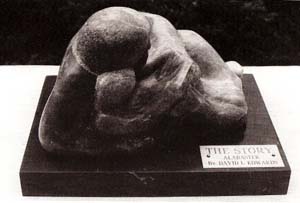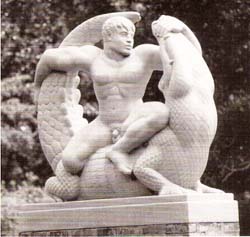- Details
-
Created: Saturday, 01 July 2000 20:45
I arrived home early one day, much to the chagrin of my two hormones-from-hell riddled sons and one of their friends. I walked into one of those “caught in the act” moments where the three of them were crammed onto the sofa, faces red, giggles suppressed. More revealing, however, when asked what they’d been doing, was the overly hearty, perfectly in unison “Nothing!”. (The McGuire Sisters would have been proud.) It did not take a psychic to know that several of “those” magazines were causing the couch to list severely to port - I could see them peeking out from under the cushions.
With great exhaustion - even I was tired of my “anyone can look like that with enough silicon”, “let’s talk about gravity”, “knock it off or I’ll subscribe to Playgirl” lectures - I demanded they hand over their reading material. I almost went belly-up when I was given four back issues to the two major sculpture magazines printed in the country.
Hadn’t we gone beyond the “snickering at nudes in art” phase yet? It took the smart-mouth friend to quickly bring me to reality as he furiously flipped through the now dog eared pages and pointed out various forms of genitalia, both attached and not, human and not recognizably so, featured repeatedly in all issues. They appeared under titles like “Taken by Art” (Art who I wondered). At the end of the friend’s “don’t have a cow Mrs. Earls” literary tour, we all voted on our favorite example. “Penis-in-a-Box” won hands down. This enjoyable mother/son moment over, I sent them on to mom -approved violent video games.
Before I proceed let me state in capital letters that I AM NOT FOR CENSORSHIP. ALMOST ALL ART IS RELEVANT SOMEWHERE TO SOMEONE. ALL ARTISTS SHOULD BE FREE TO CREATE AND HAVE A VEHICLE TO DISPLAY IN. So now that I’m in lower case again what is my point? After trying to explain to three tittering males the artistic significance of a female cat with tail raised, obviously ready to party, (“well you won’t see it on my mom’s coffee table” retorted the overly verbal spare child), I did feel some need to ponder what erotic art is exactly.
Going back over a year or more of issues it did appear that “personal property” - more often than not detached from the rest of the human form - had become quite the litmus test for determining many of the up and coming (so to speak) artists in the “real” art world. So with so much to choose from, what does define erotic art? As always, I was willing to sacrifice countless hours researching these very issues. I asked four twenty-somethings I work with, my mom and some old guy what was their definition of erotic art. Then I looked at two reputable books on the subject. When asked what they considered erotic art they agreed on very little. Erotica in art can be narrowed down to anything from some person dressed from head to toe in furs with the implication they might be naked under all of it, to the drawings in the So You Want to Be a Gynecologist textbook. The twenty-something males did agree images of any two women together doing anything - even farming, and any adult female in short pleated skirts and knee socks went without saying. Other than that the only thing my sample group actually agreed on was no kids and no violence (like I hang with a group that would admit that anyway). Realizing that if the Supreme Court and my mom couldn’t figure out a clear definition, who was I to tackle the job, so I decided to peruse my elite sculpture mags and let them define erotic art for me.
I now must admit that I looked at this “seductive” stuff over and over and still didn’t get it. One was an empty kimono draped “just that way”. Okay I’ll think more before I hang up my clothes next time, but universally erotic? Worthy of a national publication? Maybe I’m slipping, but the huge cloth geoduck-emerging-from-cornucopia didn’t do much for me. Then there was the object on the wall that looked just like the gizmo with brushes that you’re supposed to step into to clean your shoes, only it was oval. Needless to say I’ll think twice before putting my foot into one of those again. So obviously, even though some of it may be “great” art by someone’s standards, seductive it didn’t seem.
I quickly moved on to the more literal pieces. Well, what can I say? One either enjoys looking at inert, free floating, graphically portrayed “privates” or one doesn’t.
Since this visual tour didn’t enlighten me, perhaps the interviews with the creators themselves would. I only wished I could have asked the questions of the artist. No one asked the direct questions I wanted answered, like “What’s with the orifice on the wall bit - is it in the same league as a moose head?” Nevertheless I read on. Covered heavily in the rhetoric of the artistically enlightened were lots of statements by both male and female artists about “empowering women”. Now possibly the aforementioned “Penis-in-the-Box” could fit this explanation, but this statement, was used in reference to the basic vaginal theme of most of the art. Again I just don’t get it (I know, I don’t get lots of things). If the artists had said they were working through abuse, found the forms beautiful, or simply had a great time making them, I could understand. I’m of the age, however, where women have spent most of our lives trying to prove that contrary to historical accounts, our power is not found in the recesses of our Levis.
So what have I learned? Nothing. I knew already that erotica is in the eye of the beholder and that to define it is almost impossible. I also knew that not too much offends me as long as it’s made with integrity and pride and with no intent to injure the innocent. I still have no idea why potatoes in the corner and sexual organs on the wall are the current ballyhoo of the art critics. Again, not that they shouldn’t be, just that I’ve never met anyone who has a good answer to why they are.
So all of you out there who do understand, please be patient with me - I applaud anyone’s success these days in the arts, no matter what they choose to create.
Oh I did learn one thing. If you find an old hula-hoop with mold growing on it, stick it on your wall. It might just turn out to be great erotic art.
- Details
-
Created: Tuesday, 02 May 2000 06:49
In the course of fairly extensive travels by sea (on my 31-foot ketch), air, and land, I’ve had the good fortune to visit a number of art locations—be it museums or archeological sites—and I have compiled a mental list of what I call “Gems of Museums.”
These are not the major, massive, monumental, multi-faceted, mega-museum behemoths of world renown, such as the British Museum, the Louvre, The Prado, Uffizi, Vatican Museum, the Met, the Cairo Museum, etc., where a mindnumbing encyclopedic array of masterpieces exhilarate and then exhaust one with the sheer volume of sensory overload that eventually sets in. True, these are great places to study selectively given art periods, artists or schools, but they demand time and often many revisits.
The Gems of Museums that I love to discover are those that may be small and not as well known, but have on display an exquisite, uncluttered collection of the finest representative works of the region or artistic epoch. Furthermore, the works are tastefully presented and informatively ordered in a building or setting that is in itself a work of art that complements the collection it houses.
Perhaps the best contrast of the massive and the Gem that comes to mind is in Egypt. On arrival in Cairo for a two week visit we spent the first day being overwhelmed by the sheer mass of Egyptology in the incredible Cairo Museum. When we eventually reached Luxor a week later, the process of creating some order out of the chaos of dynasties and their artistic output was vastly enhanced by a visit to that Gem: The Luxor Museum. The pleasing building housed a beautifully selected array of the finest works of the various periods in a lovely setting where one could appreciate in uncluttered fashion the exquisite workmanship of their masterpieces. By the time we returned to Cairo at the end of our visit the different dynasties were beginning to fall into place for us, thanks to our having visited a number of sites, and especially the Luxor Museum.
My mental compendium of other such Gems include the lovely museum at Paestum in southern Italy, the museum at Selchuk near the ruins of Ephesus in Turkey, the Gulbenkian in Lisbon, and others.
One doesn’t have to go that far afield to find gems and/or contrasts. On a recent trip back to my old L.A. stomping grounds, I went through the hoops of getting in to visit the new Getty Museum, perched in impressive fashion in the Santa Monica Mountains overlooking the L.A. Basin. The buildings and the setting are really impressive, far more so, in fact, than the collection housed therein. The use of the space seemed unnecessarily wasteful, and navigating the galleries was so distracting that I didn’t really enjoy the visit that much. (Parenthetically, another instance of the building outshining its contents is, of course, Frank Lloyd Wright’s Guggenheim in New York.)
I next went from L.A. to visit friends in Santa Barbara. We dropped in on the Gem of a Museum there. A modest but tasteful collection including good impressionists greeted us in a handsome period building. That’s the one I remember with clarity and delight, while my experiences at the Getty is in shades of gray, fading fast.
Another favorite Gem is the Hirshhorn Museum in Washington, D.C.—a preference undoubtedly influenced by the emphasis on sculpture of a period that I particularly fancy. Also, in D.C. the Phillips Gallery meets the criteria.
There are surely many other Gems of Museums that are favorites of our members in their travels. I would love to have feedback from readers about their Gems. Always nice to consider adding a side trip to such an attraction when mapping out a trip.
Let’s hear from you on the ones that have delighted you.





